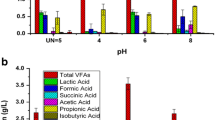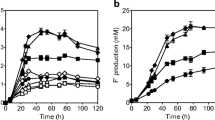Abstract
Olestra is a non-caloric fat substitute consisting of fatty acids esterified to sucrose. Previous work has shown that olestra is not metabolized in the gut and is excreted unmodified in human feces. To better understand the fate of olestra in engineered and natural environments, aerobic bacteria and fungi that degrade olestra were enriched from sewage sludges, soils and municipal solid waste compost not previously exposed to olestra. Various mixed and pure cultures were obtained from these sources which were able to utilize olestra as a sole carbon and energy source. The fastest growing enrichment was obtained from activated sludge and later yielded an olestra-degrading pure culture of Pseudomonas aeruginosa. This mixed culture extensively degraded both 14C-fatty acid labeled olestra and 14C-sucrose labeled olestra during 8 days of incubation. Longer-term incubation with pure cultures of P. aeruginosa demonstrated that >98% of 14C-sucrose labeled olestra and >72% of 14C-fatty acid labeled olestra was mineralized to CO2 after 69 days. These results indicate that olestra degraders are present in environments not previously exposed to olestra and that olestra can serve as a sole carbon and energy source. Furthermore, a common bacterial species was isolated from activated sludge and shown to have the ability to degrade olestra.
Similar content being viewed by others
References
Allgood GS (1994a) Aquatic toxicity studies of olestra in bacteria, algae, zooplankton, and fish. Society of Environmental Toxicity and Chemistry Abstract Book 15:220
Allgood GS (1994b) Terrestrial toxicity studies of olestra: Effects on plant seedling growth and on earthworms. Society of Environmental Toxicology and Chemistry Abstract Book 15:242
Allgood GS, Shimp RJ & Federle TW (1994) Biodegradation of olestra in activated sludge and soil. Society of Environmental Toxicology and Chemistry Abstract Book 15:206
Atlas RM & Bartha R (1987) Microbial Ecology — Fundamentals and Applications. The Benjamin/Cummings Publishing Co., Inc, Menlo Park, CA
Bergholz CM (1992a) Safety Evaluation of Olestra. In: Finley JW, Robinson SF & Armstrong DJ (Eds) Food Safety Assessment (pp 392–399), Washington, DC, American Chemical Society
Bergholz CM (1992b) Safety evaluation of olestra, a nonabsorbed, fatlike fat replacement. Critical Reviews in Food Science and Nutrition 32: 141–146
Breed RS & Murray EGD (1957) Bergey's Manual of Determinative Bacteriology. The Williams and Wilkins Co., Baltimore, MD
Carpenter D (1977) Microbial transformation of 14C-labeled 2,4,6-trinitrotoluene in an activated-sludge system. Applied and Environmental Microbiology 35:949–954
Eastwood MA & Allgood GS (1995) The effect of olestra on breathgas production and fecal microbial counts. European Journal of Clinical Nutrition 49: 627–639
Gilman JC (1945) A Manual of Soil Fungi. Collegiate Press, Ames, IA
Glueck CJ, Jandacek RJ, Subbiah MTR, Gallon L, Yunker R, Allen C, Hogg E & Laskarzewski PM (1980) Effect of sucrose polyester on fecal bile acid excretion and composition in normal men. The American Journal of Clinical Nutrition 33:2177–2181
Jandacek RJ & Holcombe BN (1991) The excretion and characterization of intravenously administered olestra. Lipids 26:754–758
LaFranconi WM, Long PH, Atkinson JE, Knezevich AL & Wooding WL (1994) Chronic toxicity and carcinogenicity of olestra in Swiss CD-1 mice. Food and Chemical Toxicology 32: 789–798
Leadbetter E & Foster J (1958) Studies on some methane-utilizing bacteria. Archiv fur Mikrobiologie 30:91–118
Logan TJ, Harrison B, McAvoy DC & Greff JA (1993) Effects of a fat substitute food product (olestra) in sewage sludge on soil physical properties. Agronomy Abstracts 0:39
McAvoy D, Shimp R, Namkung E & Hand V (1996) Fate and effects of olestra, a fat substitute, during conventional wastewater treatment. Water Environment Research 68: 169–177
McGinnis MP (1980) Labortory Handbook of Medical Mycology. Academic Press
Miller KW & Allgood GS (1993) Nutritional assessment of olestra, a non-caloric fat substitute. International Journal of Food Sciences and Nutrition 44:S77-S82
Miller KW, Lawson KD, Tallmadge DH, Madison BL, Okenfuss JR, Hudson P, Wilson S, Thorstenson J & Vanderploeg P (1995) Disposition of ingested olestra in the Fisher 344 rat. Fundamental and Applied Toxicology 24:229–237
Miller KW, Wood FE, Stuard SB & Alden CL (1991) A 20-month olestra feeding study in dogs. Food and Chemical Toxicology 29:427–435
Nuck BA, Schlagheck TG & Federle TW (1994) Inability of the human fecal microflora to metabolize the nonabsorbable fat substitute, olestra. Journal of Industrial Microbiology 13:328–334
Overcash RM, Versteeg DJ, Koerwer J, Li Y & Li P (1994) Plant growth response to olestra as related to beneficial use of municipal sludge. Archives of Environmental Contamination and Toxicology 26:408–414
Rosebury T (1962) Microorganisms Indigenous to Man. McGraw-Hill Book Co., Inc, New York
Wood FE, Tierney WJ, Knezevich AL, Bolte HF, Maurer JK & Bruce RD (1991) Chronic toxicity and carcinogenicity studies of olestra in Fischer 344 rats. Food and Chemical Toxicology 29:223–230
Author information
Authors and Affiliations
Rights and permissions
About this article
Cite this article
Lee, D.M., Ventullo, R.M. Degradation of olestra, a non caloric fat replacer, by microorganisms isolated from activated sludge and other environments. Biodegradation 7, 257–265 (1996). https://doi.org/10.1007/BF00058185
Accepted:
Issue Date:
DOI: https://doi.org/10.1007/BF00058185




